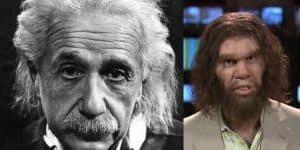The Scientist and the Caveman
I first heard this idea from Sifu Donaue a few years ago and I loved it. In order to practice martial arts effectively and become great, you have to be part scientist and part caveman. Everybody enters the dojo inclined to be one or the other. Most big guys swing their arms hard in our Adult Martial Arts class and are content with just swinging harder, as a caveman swings a club. Other students timidly try to figure out exactly how to do a technique before really putting in the physical effort, often times just standing and observing the other students like a scientist.
Either one of these mindsets by itself is incomplete and will never lead to great technique or create a well-rounded martial artist. Only by combining both the raw effort and will of a caveman and the precision and experimentation of a scientist can a student really become great. The toothpaste made me realize, however, that it’s not really both at the same time. It’s the alternation between effort and precision that hones us.
When a swordsmith crafts a samurai’s katana, he pounds out different types of Tamahagane (steel) with both high-carbon content, which is very hard and allows for a razor-sharp edge, and low-carbon, which is very tough and allows for shock absorption. He then folds them over to combine them. Again and again he pounds them out and folds them over. Eventually the sword becomes more and more perfect, both incredibly tough and razor-sharp. In the same way, we must have both effort and precision. We pound ourselves out through mental and physical effort, then precisely fold over and sharpen our technique.
I myself was very much a scientist when I began Kung Fu and T’ai Chi years ago. I was happy to dive into the details of technique, but much less likely to throw them as hard as I could. This became clear one afternoon at a demonstration that Sifu Brown gave with students of our school in Michigan. After a group of us showed off some basics and forms, I was pulled up to break a piece of concrete with a knifehand. I had never broken anything before, but I wasn’t really nervous. I knew exactly how my arm should move, and what part of my hand to hit with. Yet when Sifu gave me the count down and I let my knifehand fly, it landed with a disappointing thud on the concrete. He gave me another countdown and I let it fly again, this time with a sore hand and some trepidation. Another thud.
The next year at Kung Fu retreat I was able to break concrete with the same knifehand, the main difference being an understanding that what was missing the first time was the raw effort. This is also what Bruce Lee called emotional content. A sloppy punch or kick that is only thrown hard will usually have little effect on its intended target, and will often harm the person throwing it. A punch or kick that has all the correct movements and is crisp and clean will look good and keep the martial artist safe, but still might not break the target. Once we add back in that fiery effort, that emotional content, then the technique will do its job. When we do the same with our practice and in our lives, we get the maximum output.



